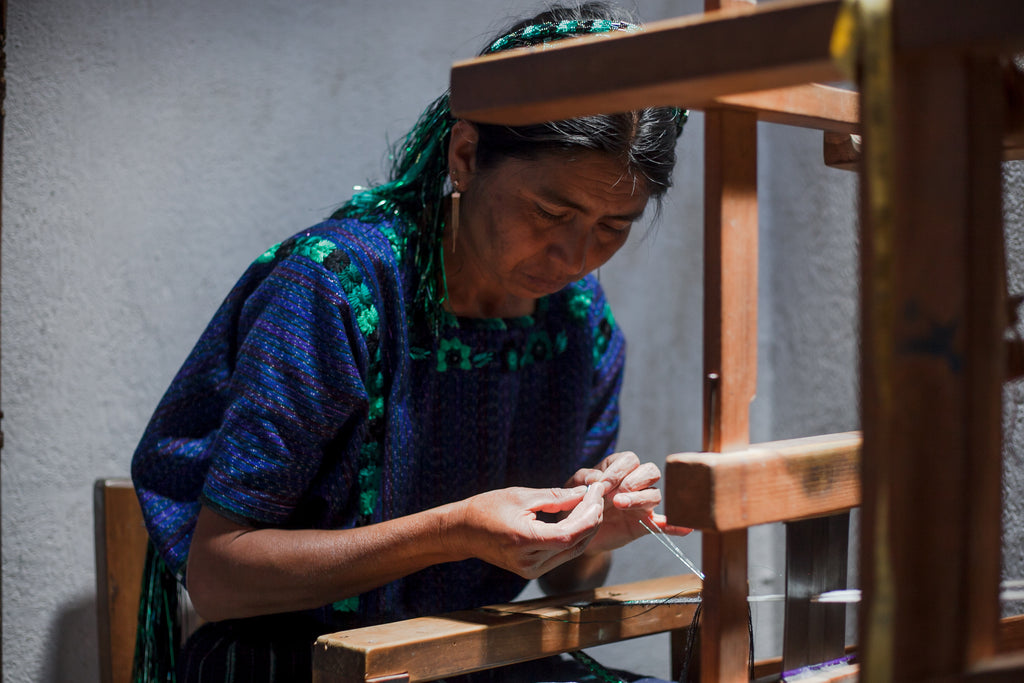Follow along for an unforgettable day as we visit our artisan Maria, in her village of San Antonio Polopó. Picturesquely set along the edge of Lake Atitlán, San Antonio is the perfect place to explore the traditional Maya art of weaving. San Antonio, as you soon discover, has incredibly preserved their Maya culture in such a way that the entire town is incredibly proud of their culture, whether by wearing the traditional clothing and the intricate tocoyal hair wraps, or through maintaining their indigenous language of Kakchiquel.
Upon your arrival, you begin walking to Maria’s home, set high up off the street, accessible by the steep concrete stairs that zig-zag their way right to her front door. When you knock on the front door, Maria’s smiling face greets you and she embraces you, giving you a small kiss on the cheek as you exchange hello’s.

Maria guides you through her house to the back work station, where her weaving area is arranged in order to clearly see every single step of the product creation process. As you look around the room, four different stations are set up.
Maria guides you towards the first step where you see an instrument that seems to be creatively attached to a bicycle wheel! Since this is the first step of the weaving process, it is vital that the materials are prepared properly. Curious to see how this is used, you take a seat nearby and wait to find out! Maria begins to show you the process, as she explains that this tool is called a redina, a wheel crossed by an iron which contains a crank that rotates the wheel. When you turn the wheel, it creates a motion in which the thread is spun. Depending on what she is crafting, Maria may spend up to 3 straight days, simply separating the thread using the traditional redina method.

After Maria is done using the redina, you move along with her to the second station, where she explains the process of the urdidora. This is a piece of equipment that Maria uses before she begins weaving in order to separate the thread. During this step, Maria chooses the amount of thread, which colors to use, and what order to combine them in to create her one-of-a-kind designs.

Perfectly placing the organized thread, Maria ensures that everything is ready to go before moving on to the third part of the process, the weaving loom. From this point, Maria can move this prepared thread to either the Backstrap Loom or to the Bead Loom, depending on the product that she is making that day.
The back-strap loom has ancient roots in Maya culture. With tensed straps around her back, Maria is deeply connected both mentally and physically with each product she creates using the back-strap loom. In order to add tension the loom, Maria uses her body weight to chance the tensity. Depending on what product she is making, the actual weaving itself can take from around one to three days.

When Maria utilizes the pedal loom to craft a tocoyal, one of her hair wraps, it takes about two days. Maria creates products on the pedal loom, multitasking like none other as she weaves a row of beads onto the thread. She continuously pedals the machine with her feet in order to cause a back and forth motion of the machine, pushing each row of beads closer to each other so each row is tight and held into place.

Any open sides of huipiles or ends of tocoyales, table runners and other products are then meticulously sewn on a sewing machine.
Finally, it’s time to embroider. This is by far the longest single step of the process. Since all embroidery is done by hand and there is much value in intricately embroidered products, this step takes at minimum 15 days, sometimes even up to 25 days, depending on the intricacy of the huipil or other garment.

If Maria is creating a huipil, often there are lines of embroidery running vertically up and down the garment, and these can be either incredibly thin and detailed or thick and bold. After the lines of embroidery are done, Maria takes special care to embroider the huipil’s collar around the cutout for the neck. This is an especially important part to ensure that no mistakes are made!
Maria is finally done with the process from beginning to end of weaving a product! Wow! You look at Maria and shake your head. How in the world does she do it? Suddenly you realize what a talented weaver Maria is as various women throughout the pueblo begin to drop off their huipiles, so that Maria can put her special touch on it.
We are blessed with some of the most gifted and talented artisans who we are so thankful to have! Book your trip to visit Maria here so that you can see for yourself the incredible process that it takes to create every one of a kind product!
--











